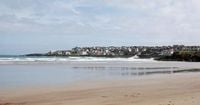On the usually vibrant North Coast of Northern Ireland, a cloud of disappointment has settled over beachgoers and swimmers as bathing bans were imposed on two of the region’s most popular beaches—Downhill and Portstewart—following the detection of high levels of blue-green algae. The warnings, which came into effect on Tuesday, September 23, 2025, have not only disrupted the routines of locals and tourists alike but have also raised growing concerns about the health of the region’s waterways and the broader environmental challenges facing the area.
According to the BBC, the Department of Agriculture, Environment, and Rural Affairs (DAERA) observed the alarming algae levels during their regular scheduled monitoring on Monday, September 22, 2025. The findings prompted immediate action, with DAERA confirming that parts of Magilligan, Downhill, and Portstewart strands were affected. The department stated that monitoring would continue and that advice would be provided to bathing water operators as new information emerged.
The National Trust, which manages Portstewart Strand, issued a clear warning to the public, reporting that algae had been detected at a “red alert level.” In their statement, they urged all visitors not to swim, to avoid any scum or mats on the shore, and to keep pets away from the water. “Remain vigilant,” the Trust emphasized, echoing the advice of environmental authorities. The message was straightforward: don’t swim, don’t fish, don’t wade, and don’t let your pets near the water—at least until further notice.
Nicole Morelli, a member of the Menopausal Mermaids open water swimming group, captured the community’s disappointment in a conversation with the BBC. “We had such a great day yesterday, and we were really looking forward to getting back in. But it’s better to be safe,” she said, reflecting a mix of frustration and understanding that has become all too familiar for those who cherish the North Coast’s beaches.
While Downhill and Portstewart have been singled out with official bathing bans, Castlerock beach has also seen increased levels of blue-green algae. As of September 24, 2025, no formal bathing notice had been issued there, but local authorities have urged beach users to be vigilant. The Causeway Coast and Glens Borough Council has repeatedly advised caution, warning the public to avoid swimming, fishing, wading, boating, and kayaking in potentially affected waters, and to keep pets under strict control. “Pet owners should ensure that their animals do not have access to this water, dogs should be kept on a lead and away from the tide line,” the council stated, emphasizing the risks not only to humans but also to animals.
Blue-green algae, or cyanobacteria, is not a new phenomenon for the region. According to Newsletter, the algae has been present in Lough Neagh—the UK’s largest freshwater lake—throughout the summer of 2025, marking its third consecutive year of significant blooms. This year’s weather conditions have exacerbated the problem, with portions of the algal mats traveling along the Lower Bann River and eventually reaching the North Coast beaches. The situation has had ripple effects beyond recreational swimming; for instance, the eel-fishing season at Lough Neagh was cut short this summer due to the persistent blooms, a blow to both local fishermen and the broader ecosystem.
Exposure to blue-green algae is no trivial matter. As reported by Newsletter, contact with contaminated water can cause skin irritation, vomiting, and headaches in humans. Pets, however, are at even higher risk and can die from exposure. The warnings from authorities are therefore not mere formalities—they are urgent public health advisories designed to prevent potentially serious harm.
The recurrence and severity of the blue-green algae problem have prompted a search for more robust solutions. In a bid to get ahead of future outbreaks, the UK Space Agency has stepped in with an £800,000 funding award from its Unlocking Space for Government programme. This investment will support the development of an operational remote sensing system aimed at predicting, detecting, and monitoring blue-green algae across affected waters. The project, part of phase two of a small business research initiative (SBRI), is slated to run until April 2026, offering hope that technology could provide early warnings and more targeted interventions in the years ahead.
The recent bans are not without precedent. In August 2025, Benone beach—another North Coast favorite—was temporarily closed due to an algae-related bathing ban, though that restriction was lifted after a few days as conditions improved. The quick response and ongoing monitoring by DAERA and local councils have been credited with minimizing risk, but the recurrence of such incidents has underscored the need for both immediate vigilance and long-term solutions.
For now, the advice from authorities is clear and consistent. The National Trust and local councils are asking the public to avoid any interaction with algae, including playing with scum or mats on the shore, and to keep all animals away from affected waters. The Department of Agriculture, Environment, and Rural Affairs has pledged to continue regular monitoring and to update the public as the situation evolves. “Currently beach users are asked to be vigilant to the possible presence of blue green algae,” the Causeway Coast and Glens council reiterated, urging extra caution especially at Castlerock beach, where conditions could change rapidly.
Behind the scenes, environmental scientists and government agencies are racing to better understand the underlying causes of the recurrent blooms. While some factors, such as weather patterns and water temperature, are beyond human control, others—like nutrient runoff and pollution—are the focus of ongoing research and policy discussions. The hope is that by combining technological innovation, public awareness, and coordinated management, the region can reduce the frequency and impact of blue-green algae events in the future.
In the meantime, the North Coast community is left grappling with the reality of climate and environmental change at their doorstep. For swimmers like Nicole Morelli and her friends, the message is clear: safety comes first, even if it means missing out on a cherished day at the beach. As the summer of 2025 draws to a close, the story of blue-green algae serves as both a cautionary tale and a call to action—a reminder that the health of our natural spaces is inextricably linked to the choices we make and the vigilance we maintain.
With continued monitoring, new technologies on the horizon, and a community committed to both safety and stewardship, there’s hope that the North Coast’s beaches will soon be safe for all to enjoy once again.





